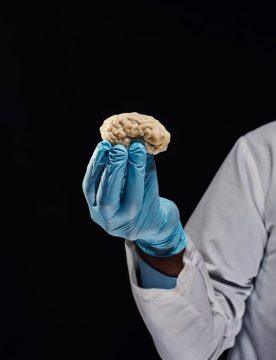Matthew Shaer in The New York Times:
 A few years ago, a scientist named Nenad Sestan began throwing around an idea for an experiment so obviously insane, so “wild” and “totally out there,” as he put it to me recently, that at first he told almost no one about it: not his wife or kids, not his bosses in Yale’s neuroscience department, not the dean of the university’s medical school. Like everything Sestan studies, the idea centered on the mammalian brain. More specific, it centered on the tree-shaped neurons that govern speech, motor function and thought — the cells, in short, that make us who we are. In the course of his research, Sestan, an expert in developmental neurobiology, regularly ordered slices of animal and human brain tissue from various brain banks, which shipped the specimens to Yale in coolers full of ice. Sometimes the tissue arrived within three or four hours of the donor’s death. Sometimes it took more than a day. Still, Sestan and his team were able to culture, or grow, active cells from that tissue — tissue that was, for all practical purposes, entirely dead. In the right circumstances, they could actually keep the cells alive for several weeks at a stretch.
A few years ago, a scientist named Nenad Sestan began throwing around an idea for an experiment so obviously insane, so “wild” and “totally out there,” as he put it to me recently, that at first he told almost no one about it: not his wife or kids, not his bosses in Yale’s neuroscience department, not the dean of the university’s medical school. Like everything Sestan studies, the idea centered on the mammalian brain. More specific, it centered on the tree-shaped neurons that govern speech, motor function and thought — the cells, in short, that make us who we are. In the course of his research, Sestan, an expert in developmental neurobiology, regularly ordered slices of animal and human brain tissue from various brain banks, which shipped the specimens to Yale in coolers full of ice. Sometimes the tissue arrived within three or four hours of the donor’s death. Sometimes it took more than a day. Still, Sestan and his team were able to culture, or grow, active cells from that tissue — tissue that was, for all practical purposes, entirely dead. In the right circumstances, they could actually keep the cells alive for several weeks at a stretch.
When I met with Sestan this spring, at his lab in New Haven, he took great care to stress that he was far from the only scientist to have noticed the phenomenon. “Lots of people knew this,” he said. “Lots and lots.” And yet he seems to have been one of the few to take these findings and push them forward: If you could restore activity to individual post-mortem brain cells, he reasoned to himself, what was to stop you from restoring activity to entire slices of post-mortem brain?
To do so would be to create an entirely novel medium for understanding brain function. “One of the things we studied in our lab was the connectome — a kind of wiring map of the brain,” Sestan told me. Research on the connectome, which comprises the brain’s 90 billion neurons and hundreds of trillions of synapses, is widely viewed among neuroscientists as integral to understanding — and potentially treating — a range of disorders, from autism to schizophrenia. And yet there are few reliable ways of tracing all those connections in the brains of large mammals. “I thought, O.K., let’s see if this” — slices of cellularly revived brain tissue — “is the way to go,” Sestan said.
More here.
